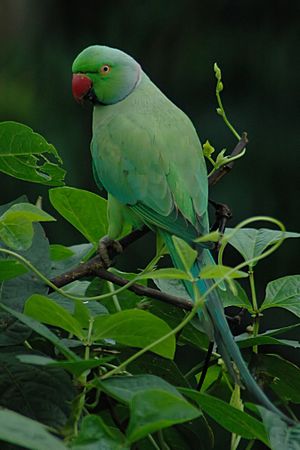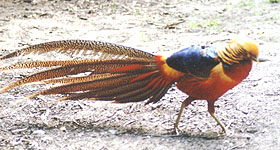List of non-native birds in Great Britain facts for kids
Since the Victorian era, many bird species have been brought to Britain. Some were introduced for sports like hunting, others for their beauty, and some just for experiments. While some of these birds have made Britain their new home, others haven't survived. Some birds have also escaped from zoos or private collections and started living in the wild. However, many of these escapees don't last long, especially in harsh weather.
This page tells you about the bird species that have successfully settled and formed groups in the British Isles. Some non-native birds have even become "naturalised" after flying here on their own and starting families, like the collared dove. The list below includes all the bird species that have lived in the wild in Great Britain.
Sometimes, birds that have escaped from captivity, like the ruddy shelduck, can make it tricky for birdwatchers. They might look like wild birds that have flown here naturally!
The birds listed below have created groups in the UK at some point. Some might have left or died out, or new groups might have started in other places.
Contents
Birds in Britain: New Arrivals
Many birds you see in Britain today weren't always here. They arrived in different ways:
- Introduced: People brought them here on purpose.
- Escaped: They broke free from captivity, like from zoos or private collections.
- Natural Migrants: They flew here on their own, often from other countries.
Some of these new arrivals have done very well and now have large populations.
Water Birds and Geese
- Black-crowned night heron: Since 1951, a group of these birds has lived freely at Edinburgh Zoo in Scotland. There's also a similar group in Great Witchingham, Norfolk.
- Black swan: These beautiful swans often escape from collections. You can find single birds or pairs on many lakes. Several pairs breed each year, but they haven't formed big, lasting groups yet.
- White-fronted goose: Wild white-fronted geese don't usually breed in the UK. A small breeding group on Islay in Scotland came from a bird collection. You might see these "feral" (wild-living but from captive origin) birds mixed with other geese.
- Domestic goose: These are common farm birds that escape. You can find them anywhere, and they often breed with greylag goosees.
- Bar-headed goose: About 15 pairs of these geese now breed in scattered places across the UK.
- Snow goose: Wild snow geese appear in Scotland every year. Any you see in summer are usually escapees. A small group lives between the islands of Coll and Mull in Scotland.
- Emperor goose: These are occasional escapees. You might see them among groups of other wild geese. They have bred in Walney Island and Essex.
- Swan goose: The domesticated version, called the Chinese goose, often escapes from farms. You can find them on small ponds. "True" swan geese are less common escapes.
- Canada goose: First brought here in the 1600s, this bird has now spread all over the country and is very common. Large groups, sometimes hundreds of birds, are a common sight on man-made waterways.
- Barnacle goose: A group of these birds now lives in southern England, with strong numbers in East Anglia, Lincolnshire, and other areas. These birds usually stay in Britain all year.
- Egyptian goose: First introduced in the 1600s, these geese were historically found on private estates. They are now common in Norfolk and have spread west.
- Ruddy shelduck: These birds are often seen across Britain, especially in Norfolk. However, confirmed breeding is rare. Some sightings might even be truly wild birds from Europe or Africa.
- Muscovy duck: A common escapee, often seen on park lakes where people feed ducks. Breeding pairs can be found across the country. A well-established group lives in Cambridgeshire.
- Domesticated duck: This is the typical "farmyard duck," which came from the Mallard. You can find them on almost any city waterway. They easily breed with wild mallards.
- Wood or Carolina duck: A small group used to live in Bedfordshire, but it has now shrunk. You can find them breeding at other places in southern England.
- Mandarin duck: This beautiful bird from Asia was introduced for its looks. Escapes and planned releases have led to a large and growing population. They are most common in the Home Counties.
- Ruddy duck: Introduced to Gloucestershire in the 1950s after escaping from a wildlife trust. It spread quickly across central England. Now, there's a program to remove them because they threaten the white-headed duck in Europe.
- Red-crested pochard: A group has settled in scattered areas across southern England. A strong breeding group lives in the Cotswold Water Park.
Game Birds and Pheasants
- Bobwhite quail: Introduced for hunting in many areas. Groups settled in Suffolk and the Isles of Scilly, but they are rarely seen now.
- Red-legged partridge: Introduced for hunting in the 1700s, this bird is now common across much of England. Many are still released for shooting.
- Chukar: Introduced many times for hunting in the past. They often bred with red-legged partridges until releases were stopped in 1992. They are now very rare or gone.
- Reeves's pheasant: Introduced in the 1800s but later died out. They are still released for hunting, and you might find them anywhere in the UK.
- Silver pheasant: Introduced several times for hunting and beauty, but they didn't settle in the wild. They are seen occasionally.
- Green pheasant: Introduced for hunting. They easily breed with common pheasants. Releases continue, and some people think they might be breeding in Norfolk.
- Common pheasant: First introduced as far back as Roman times, this bird is now very common everywhere except in cities and on high ground. Millions are released each year for hunting.
- Golden pheasant: Introduced to many areas for their beauty and for hunting. You can find them anywhere, but their numbers are decreasing. Their main home is still the Breckland of Norfolk.
- Lady Amherst's pheasant: Introduced for hunting and beauty. The small group remaining is mostly in Bedfordshire and is almost gone.
- Indian peafowl: Free-roaming birds have escaped and bred sometimes, as seen in Norfolk and Worcestershire.
- Helmeted guineafowl: These birds might wander from farms into the countryside and have bred sometimes.
Pigeons, Parrots, and Owls
- Feral pigeon: These are descendants of escaped (and released) domesticated rock doves. They are one of the few truly "feral" species, meaning they live wild after being domesticated.
- Barbary dove: Escaped cage birds have bred. Their current status is hard to tell because they look very similar to the collared dove.
- Alexandrine parakeet: This bird looks very much like the ring-necked parakeet. It often escapes and has bred in the past.
- Ring-necked parakeet: Introduced in the 1960s, this bird is now common in south-east England. Flocks of thousands gather to sleep in places like Kent and Greater London. They have adapted well to city gardens and are spreading to new areas.
- Blue-crowned parakeet: Escapees have bred in Southern England.
- Monk parakeet: Several groups have formed in recent years, especially in Hertfordshire and Surrey.
- Budgerigar: There used to be several groups of these birds, including a famous one on the Isles of Scilly. Now, you're most likely to see them as single escapees.
- Eurasian eagle owl: A famous pair has settled in North Yorkshire, attracting a lot of media attention. No one is sure if they are escapees or wild birds.
- Little owl: First seen in 1842, this owl is now well established throughout England and Wales.
Other Birds
- Red-winged laughingthrush: One escaped pair of these interesting birds bred on the Isle of Man. However, this group is thought to be gone as of 2019.
- Yellow-fronted canary: These cage birds sometimes escape, but they often don't survive long in Britain's climate.
- Domestic canary: Escaped canaries have survived in the wild for some time, but they are not thought to have bred.
- Common waxbill: Cage birds of several species escape from time to time.
- Zebra finch: This bird is very common in bird keeping and breeds easily. Small groups might form after several escape, but they rarely last long.
- Red-billed leiothrix: A brightly coloured songbird from Asia. Most sightings are from Wiltshire and Somerset. These birds nest together in groups, so they can breed in high numbers.
It's important to remember that almost any bird kept in captivity might escape. Sometimes, it's hard to tell if a rare bird sighting is a truly wild bird or an escapee. This is a big challenge for bird experts who record rare birds in Britain.
See also
- List of introduced bird species
- Invasive species in the British Isles



